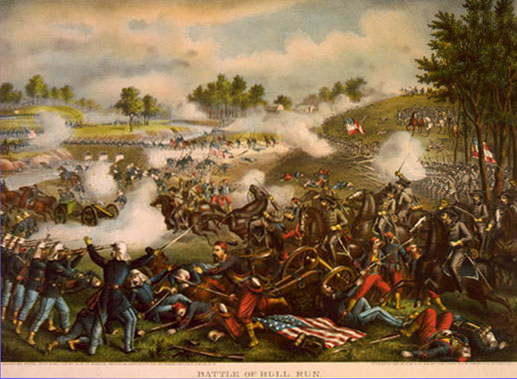Advertisement
This page tells all about the First Battle of Bull Run, the first major battle of the Civil War.
|
Battle of Bull Run I Activities
- First Battle of Bull Run Reading Comprehension - This resource includes a historical passage and ten multiple choice questions.
- Text Structure - The First and Second Battles of Bull Run - This activity requires students to read through four Bull Run-themed paragraph and to identify the text structures as: cause and effect, problem-solution, chronological, and compare and contrast
- Battle Breakdown - First Battle of Bull Run - This awesome printable helps students to essentially diagram battles! It requires students to write the cause, the players in the battle, the victor, and the effects of the battle. It comes with a descriptive narrative about the battle that students can use.
- A Perfect Day for a Picnic - Interviewing a battle spectator at Manassas - This requires students to consider the mentality of the "spectators" at the First Battle of Bull Run and conduct a mock interview.
- The Story of Wilmer McLean - This activity describes the ironic situation of Wilmer McLean, whose claim to fame was the Civil War "started in his front yard and ended in his front parlor." This activity requires students to make a comic about the situation.
- First Battle of Bull Run Fact or Fiction Printable - This fun activity requires students to read a First Battle of Bull Run passage and then, to sort 10 statements into those that are facts and those that are fiction. The program gives immediate feedback.
- First Battle of Bull Run Fact or Fiction Online - This fun activity requires students to read a First Battle of Bull Run passage and then, to sort 10 statements into those that are facts and those that are fiction. The program gives immediate feedback.
- First Battle of Bull Run Correct-me Passage - This fun activity requires students to correct a passage about the First Battle of Bull Run that has eight factual errors. Students first must discover the errors, then click on them and select the correct answer from the drop down menu.
- Intonation - Stonewall Jackson Nickname - This fun activity requires students to analyze how emphasis can change the meaning of identical sentences, and describe what Bernard Bee may have meant by uttering the famous words "there is Jackson standing like a stone wall." Was he inspired or angry? See how emphasis changes the meaning of his words.
Related activities
Advertisement


